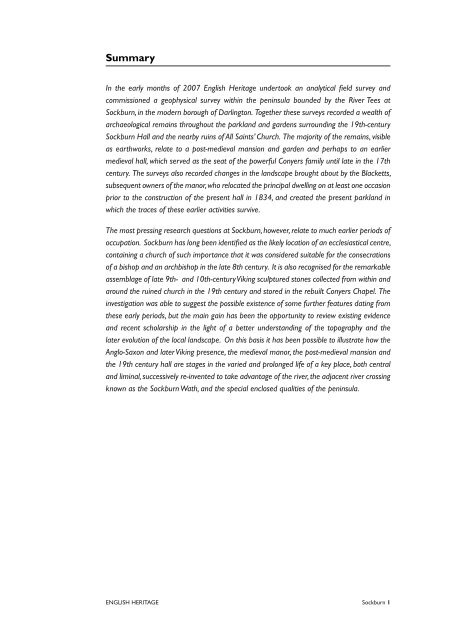Sockburn Hall, Darlington: an archaeological ... - English Heritage
Sockburn Hall, Darlington: an archaeological ... - English Heritage
Sockburn Hall, Darlington: an archaeological ... - English Heritage
You also want an ePaper? Increase the reach of your titles
YUMPU automatically turns print PDFs into web optimized ePapers that Google loves.
Summary<br />
In the early months of 2007 <strong>English</strong> <strong>Heritage</strong> undertook <strong>an</strong> <strong>an</strong>alytical field survey <strong>an</strong>d<br />
commissioned a geophysical survey within the peninsula bounded by the River Tees at<br />
<strong>Sockburn</strong>, in the modern borough of <strong>Darlington</strong>. Together these surveys recorded a wealth of<br />
<strong>archaeological</strong> remains throughout the parkl<strong>an</strong>d <strong>an</strong>d gardens surrounding the 19th-century<br />
<strong>Sockburn</strong> <strong>Hall</strong> <strong>an</strong>d the nearby ruins of All Saints’ Church. The majority of the remains, visible<br />
as earthworks, relate to a post-medieval m<strong>an</strong>sion <strong>an</strong>d garden <strong>an</strong>d perhaps to <strong>an</strong> earlier<br />
medieval hall, which served as the seat of the powerful Conyers family until late in the 17th<br />
century. The surveys also recorded ch<strong>an</strong>ges in the l<strong>an</strong>dscape brought about by the Blacketts,<br />
subsequent owners of the m<strong>an</strong>or, who relocated the principal dwelling on at least one occasion<br />
prior to the construction of the present hall in 1834, <strong>an</strong>d created the present parkl<strong>an</strong>d in<br />
which the traces of these earlier activities survive.<br />
The most pressing research questions at <strong>Sockburn</strong>, however, relate to much earlier periods of<br />
occupation. <strong>Sockburn</strong> has long been identified as the likely location of <strong>an</strong> ecclesiastical centre,<br />
containing a church of such import<strong>an</strong>ce that it was considered suitable for the consecrations<br />
of a bishop <strong>an</strong>d <strong>an</strong> archbishop in the late 8th century. It is also recognised for the remarkable<br />
assemblage of late 9th- <strong>an</strong>d 10th-century Viking sculptured stones collected from within <strong>an</strong>d<br />
around the ruined church in the 19th century <strong>an</strong>d stored in the rebuilt Conyers Chapel. The<br />
investigation was able to suggest the possible existence of some further features dating from<br />
these early periods, but the main gain has been the opportunity to review existing evidence<br />
<strong>an</strong>d recent scholarship in the light of a better underst<strong>an</strong>ding of the topography <strong>an</strong>d the<br />
later evolution of the local l<strong>an</strong>dscape. On this basis it has been possible to illustrate how the<br />
Anglo-Saxon <strong>an</strong>d later Viking presence, the medieval m<strong>an</strong>or, the post-medieval m<strong>an</strong>sion <strong>an</strong>d<br />
the 19th century hall are stages in the varied <strong>an</strong>d prolonged life of a key place, both central<br />
<strong>an</strong>d liminal, successively re-invented to take adv<strong>an</strong>tage of the river, the adjacent river crossing<br />
known as the <strong>Sockburn</strong> Wath, <strong>an</strong>d the special enclosed qualities of the peninsula.<br />
ENGLISH HERITAGE <strong>Sockburn</strong>

















